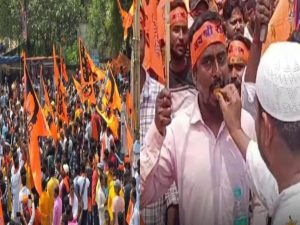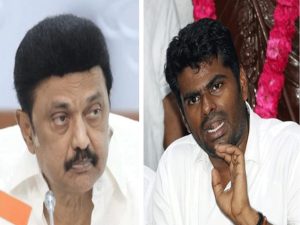
Rains have always sparked artistic imagination. Vincent Van Gogh’s rain lashed over empty farmland in intense, slanted lines; miniature artists in the Mughal and Rajput traditions drew dark clouds over lush green fields in which Krishna and his gopis danced; and in a meta commentary on individuality, René Magritte poured his own bowler-hatted self from the sky in “Golconda.”
The arrival of the monsoon can turn us all into pluviophiles, but perhaps it affects artists more than the rest of us. We asked five artists from across India what the season means to them.
An artist and researcher in Mumbai reminisces about her early days in the city. “I moved to Bombay in late September of 2012 and everyone warned me of the awful October heat. I braced myself for the worst. But October decided to spare me that year; it rained every evening! Tucked in the lane flanked by a Portuguese church on one end and Siddhivinayak on the other, I watched people walk in either direction to their place of worship in pouring rain. Older couples hand in hand, wet crows that hung upside down from electric cables, lush green rain trees. Had it not been for that monsoon, I may have never learnt to love Bombay,” she reflects.
Garima Gupta, another artist, shares a more complex perspective. “I am an August born and the memory of the monsoon starting with a roar around my birthday is deeply embedded. Sometimes I have to stop and remind myself that untimely rains are wrecking standing crops and causing damage. But then we as a people have also abolished all possibilities of joy because guilt and shame are dominating our thoughts. We don’t pull up our authorities when things fall apart, but will learn to kill our only chance of joy. Yet, I find solace in the monsoon. It inspired my series of paintings, ‘Our Conspiring Hosts’. The intricate imagery and depth of the Amazon rainforest after a storm came alive on my canvas in 2023,” she says.
On the cultural side, Gupta finds joy in Bollywood movies. “I love the Bollywood songs from the 1970s and 80s, where the protagonists are enjoying the rains. There’s something about that simple joy that gets me every time. It’s nostalgic, it’s pure,” she adds.
Orijit Sen, a graphic designer and artist based in Goa, has indelible memories of the monsoon that even time cannot erode. “One of my most vivid memories is travelling on the now defunct metre-gauge train that used to run between Vasco da Gama station and Miraj Junction during the height of the monsoons. I stood at the doorway of my carriage as it crossed a bridge halfway up the swollen Dudhsagar Falls. Even at a distance, I could feel the fine spray flying off the roaring body. In the time it took us to cross the bridge, I was drenched from head to toe!”
Sen elaborates on how the monsoon influences his artistic process. “As an artist, I experience the monsoons as a transformative season. The colours of the landscape change dramatically from shades of ochre, olive, and brown, to deep, saturated greens. The quality of the light is indescribable, as it comes reflected off water bodies or refracted through millions of water droplets hanging off the foliage. I find the colour palette in my work is always influenced by these dramatic seasonal changes,” Sen concludes, highlighting a piece from his Hyderabad series.
Performance artist Debashish Paul from Varanasi found his muse in the monsoon.
. “In Banaras, when the water climbs, we head to the Nepali mandir on Tulsi Ghat, which is located at a height. You can see the whole valley move. When I came to Banaras for my Masters in 2019, the monsoon had just begun. On my first evening here, I found two young boys conducting the aarti at Tulsi Ghat, and I was infatuated with one of them. I’d visit daily for six months just to see him; I’d watch the way his body moved and transformed. That became the inspiration for my first performance work, ‘Beyond the Body and Gender.'”
Paul also shares his love for Rabindra Sangeet. “In Tagore’s songs, such as ‘Aaji jhorer raate,’ ‘Megher Pore Megh Jomechhe,’ and others, I can vividly see my village in the Nadiya district of West Bengal where we’d make boats out of banana leaves and fish in the streets when the rains came. In the monsoon songs, you feel as if you’re soaring in the sky and smelling the rain.”
Photographer and artist Sheetal Mallar from Mumbai finds the monsoon to be a time for romance and introspection. “After these brutal summers, I find the monsoon really romantic. The city is so chaotic, and this season is cleansing in so many ways. We have a lack of public spaces; we don’t have much of a park culture. So places like Carter Road, Bandstand, and Worli Seaface are really nice now. For photography, the monsoon helps you create a mood. The light is more beautiful, the colour palette of the sky and the trees changes. Moody, stormy, melancholy feelings — the season’s really emotive. But I also find myself doing a lot of my drawings and paintings in the monsoon, for which, unlike when taking pictures, I feel I need to go more inwards.”
Her favourite activities during this season include swimming and long walks. “I love to swim in the rain and go for long walks — I own two pairs of gum boots. Songs like Shubha Mudgal’s ‘Ab Ke Saavan’ and Billie Holiday’s ‘Stormy Weather’ sound sweeter. And it’s the time to feast on plates of bhajiya and samosas,” she says.
Multi-disciplinary artist Gaurav Ogale shares a montage of his monsoon memories. “Standing drenched outside Sassanian Bakery in Mumbai, enveloped by the smell of freshly baked khari; experiencing the first showers on our barsaati in my hometown Pune; the smell of the ironed rasai (quilt) at my grandparents’ home. I love visiting Panchgani during the rains, and even embrace the monsoon in Berlin.”
Ogale finds parallel experiences of monsoon and life in different art forms. “I love the way Orhan Pamuk captures hüzün (melancholy), especially the way he talks about the winters in his book Istanbul: Memories of a City. It’s a lot like what the monsoons mean to us in this part of the world. I find similar connotations between the monsoon and life — longing, memory, seasons, love, identity — in the works of artists such as Anju Dodiya, Arshi Ahmadzai, Hashim Badani; in films like Water by Deepa Mehta, Wong Kar-wai’s In the Mood for Love, Mira Nair’s Monsoon Wedding, the underlying melancholy in Sergei Parajanov’s The Color of Pomegranates, and in the music of Kumar Gandharva, Blaze Foley, Anika Pyle.”
In every story and revelation, we see how the monsoon season transforms everyday life into a canvas of inspiration for artists across India. The rains, whether welcomed or feared, undoubtedly evoke deep emotions and unfold countless tales of personal and creative evolution.












